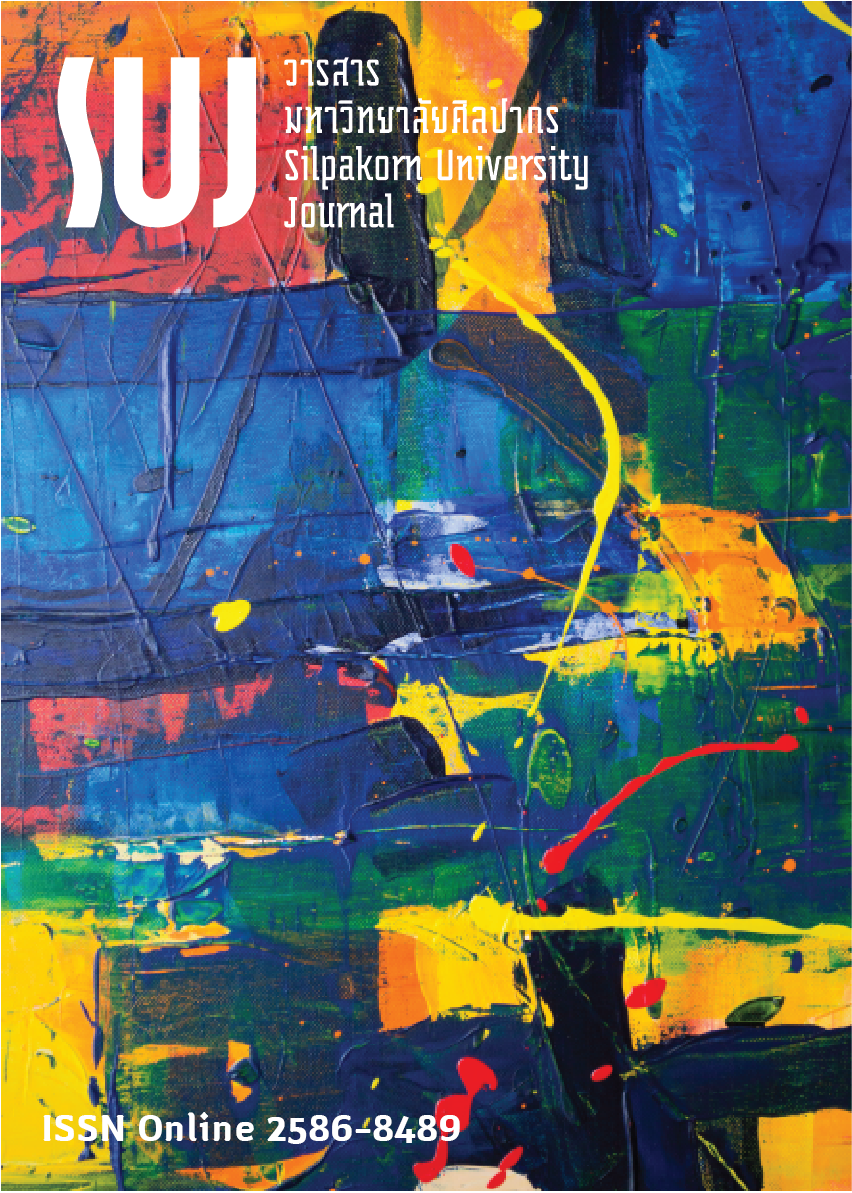ผลการใช้การเล่านิทานในการพัฒนาความสามารถด้านการออกเสียงภาษาอังกฤษของนักศึกษาวิชาชีพครู สาขาภาษาอังกฤษ (The impacts of using storytelling on student teachers’ pronunciation, English major)
Main Article Content
Abstract
งานวิจัยนี้มีวัตถุประสงค์เพื่อศึกษาผลของการเล่านิทานต่อการพัฒนาการออกเสียงภาษาอังกฤษในนักศึกษาวิชาชีพครู สาขาวิชาภาษาอังกฤษ ชั้นปีที่ 4 จำนวน 27 คน มหาวิทยาลัยราชภัฏเพชรบูรณ์ ผู้วิจัยใช้วิธีการสุ่มกลุ่มตัวอย่างอย่างง่าย เครื่องมือในการวิจัย ประกอบด้วย 1) แผนการจัดกิจกรรมการจัดการเรียนรู้โดยการเล่านิทาน 2) แบบวัดความสามารถในการออกเสียงภาษาอังกฤษก่อนและหลังการใช้กิจกรรมการเล่านิทาน และ 3) แบบบันทึกพัฒนาการในการออกเสียงภาษาอังกฤษของตนเอง สถิติที่ใช้ในการวิจัย ได้แก่ ค่าเฉลี่ย ส่วนเบี่ยงเบนมาตรฐาน และ t-test และใช้การวิเคราะห์เนื้อหา (content analysis) ผลการวิจัยพบว่า 1) ค่าประสิทธิภาพของกิจกรรมการจัดการเรียนรู้โดยใช้การเล่านิทานเพื่อพัฒนาความสามารถในการออกเสียงภาษาอังกฤษ มีค่าเท่ากับ 78.97/75.31 ซึ่งสูงกว่าเกณฑ์ประสิทธิภาพเครื่องมือที่กำหนดไว้ 75/75 2) ความสามารถในการออกเสียงภาษาอังกฤษของนักศึกษากลุ่มตัวอย่างสูงขึ้นกว่าก่อนการทดลองอย่างมีนัยสำคัญทางสถิติที่ระดับ .05 3) การใช้การเล่านิทานทำให้นักศึกษาตระหนักถึงพัฒนาการของตนเอง ซึ่งได้แก่ พัฒนาการด้านการออกเสียง พัฒนาการด้านความมั่นใจ พัฒนาการด้านการใช้เทคนิคการเล่านิทาน พัฒนาการด้านทักษะภาษาอังกฤษ ความสามารถในการวิเคราะห์ปัญหาและการแก้ไขปัญหาของการออกเสียงของตนเอง และการเห็นคุณค่าของนิทาน
This research aimed at studying the impact of using a storytelling approach on English pronunciation in order to develop speakers’ ability. The sample, recruited from the simple random method, included 27 student-teachers who were the English major students from the Faculty of Education, Phetchabun Rajabhat University. The research instruments comprised 1) lesson plans for using storytelling to develop students’ pronunciation ability; 2) the pre-test and the post-test for testing students’ pronunciation accuracy; and 3) students’ logbooks for self-development observation. The statistical measurements included means, standard deviation, and t-test, respectively. In terms of qualitative analysis, the content analysis method was adopted to analyze such data. This study revealed that 1) the efficiency criteria of the lesson plans were 78.97/75.31, which was higher than the expected criteria of 75/75; 2) the post-test average scores of those student teachers’ pronunciation ability were higher than the pre-test score at the 0.05 level of significance after being practiced by this approach; and 3) in terms of the qualitative findings, the respondents reflected their views on their English pronunciation development and problems, namely self-confidence development, storytelling technique development, English skills development in general, self-correcting and self-internalizing with regard to marked sounds, and acknowledging storytelling’s value.
Downloads
Article Details

This work is licensed under a Creative Commons Attribution-NonCommercial-NoDerivatives 4.0 International License.
References
Arunthari, Sanhaphat. (1999). Stories for Early Childhood (นิทานสำหรับปฐมวัย). Phuket: Phuket Rajabhat University.
Cameron, L. (2001). Teaching Languages to Young Learners. Cambridge Language Teaching Library. Cambridge: Cambridge University Press.
Celce-Murcia, M., Brinton, D., & Goodwin, J. (2011). Teaching Pronunciation: A Reference for Teachers of English to Speakers of Other Languages (2nd ed.). New York: Cambridge University Press.
Chaipa, Krongkaew. (2003). Introduction to English Phonetics and Phonology (สัทศาสตร์อังกฤษและสรวิทยาเบื้องต้น). Loei: Loei Rajabhat University.
Ellis, B. F. (1997). Why Tell Stories? Storytelling Magazine, 9(4): 21-22.
Gerhiser, A. & Wrenn, D. (2007). Second Language Pronunciation Assessment Handout Packet. [Online]. Retrieved January 15, 2018 from http://teachingpronunciation.pbworks.com/f/Pronunciation+assessment+packet+.pdf
Harmer, J. (2001). The Practice of Language Teaching (3rd ed.). London: Longman.
Hawking, L. (2015). Science and Storytelling [Online]. Retrieved January 21, 2018 from https://www.youtube.com/watch?v=E7K-qlQVpgE
Heaton, J. B. (1990). Classroom Testing (2nd ed.). New York: Longman.
Hewings, M. (2004). Pronunciation Practice Activities. Cambridge: Cambridge University Press.
Justin, R. S. (2017). Perception of Spoken English Test. [Online]. Retrieved November 23, 2017 from https://eslactivities.com/pt/results.php
Kim, M. (2010). The Effect of Storytelling on Adult English Language Learners. Linguistic Research, 27(3): 447-473.
Kotcharat, Suthamas, & Limsiriruengrai, Puttachart. (2014). The Development of English Pronunciation by Using English Phonetics Exercise (การพัฒนาการออกเสียงภาษาอังกฤษโดยใช้แบบฝึกสัทอักษรภาษาอังกฤษ). [Online]. Retrieved August 15, 2018 from https://dspace.bru.ac.th/xmlui/handle/123456789/1001
Linse, T. C. (2007). Predictable Books in Children’s EFL Classroom. ELT Journal, 61(1): 46-54.
Motallebi, S., & Pourgharib, B. (2013). The Impact of Audio Stories (Listenning Skills) on Pronunciation of EFL Learners. Journal of Language Science & Linguistics, 1(1): 1-6.
Promwong, Chaiyong, et al. (1997). Instruction Material System (ระบบสื่อการสอน). Bangkok: Chulalongkorn University.
Puspa, G. (2018). Storytelling in the 21st Century. [Online]. Retrieved June 2, 2018 from https://writingcooperative.com/storytelling-in-the-21st-century-e3c372a5eb59
Saiyot, Luan, & Saiyot, Angkana. (1994). Educational Research Techniques (เทคนิคการวิจัยทางการศึกษา) (4th ed.). Bangkok: Academic Support Center.
Slattery, M., & Willis, J. (2001). English for Primary Teachers: A Handbook of Activities and Classroom Language. Oxford: Oxford University Press.
Sirichanchuen, Montri. (2011). The Teaching a Large Group in Gsoc 2101, The Development Community, Approach to Learning by Active Learning and Using E-Learning (การสอนนักศึกษากลุ่มใหญ่ในรายวิชา GSOC 2101 ชุมชนกับการพัฒนา โดยใช้การสอนแบบ Active Learning และการใช้บทเรียนแบบ e-learning). Chiang Mai: Chiang Mai Rajabhat University.
Tantipalacheewa, Kunlaya. (1998). Storytelling (การเล่านิทาน). Early Childhood Journal, 2(2): 10-19.
Taylor, E. (2000). Using Folktales. Cambridge: Cambridge University Press.
Tench, P. (1991). Pronunciation Skills. London: Macmillan.
Thaweerat, Puangrat. (2000). The Research Methodologies on Behavioral Science and Social Sciences (8th ed.). Bangkok: Chulalongkorn University Press.
Wajnryb, R. (2003). Stories: Narrative Activities in the Language Classroom. In Cambridge Handbooks for Language Teachers. Cambridge: Cambridge University Press.
Wilhem, H. (1999). Oh, the Tales You’ll Tell! English Teaching Forum, 39(9): 27-28.
Wright, A. (1995). Storytelling with Children. New York: Oxford University Press.
Wongprom, Boonlert. (2015). Thais and English Language; from ABC to AEC (ภาษาอังกฤษคนไทยจาก ABC สู่ AEC). [Online]. Retrieved February 20, 2018 from https://www.bangkokbiznews.com/blog/detail/636226
Wongsothorn, Achara. (1995). Language Test Guideline (แนวทางการสร้างข้อสอบภาษา). Bangkok: Chulalongkorn University.


